Google’s algorithm changes thousands of times every year. In 2021 alone, Google made more than 5,000 updates to its algorithm.
Although some of these updates are too small to affect your SEO strategy, you cannot turn your back on every change.
To cope with all the ever-changing algorithms, it’s important to have a versatile SEO tool that can share your burden.
Moz Pro has been known to do so for years for numerous businesses and bloggers. However, is that reason enough for you to go and get a subscription?
Absolutely not!
You have to find out whether or not Moz Pro suits your requirements.
This is where our detailed review comes in. We have covered the ins and outs of Moz Pro including, features, user interface, accuracy, customer support, alternatives, and whatnot.
Hop in to find out the nuts and bolts of Moz Pro.
What Is MozPro?
Moz Pro is a premium all-in-one SEO toolkit offered by Moz. The tool was earlier named SEO Moz when it was first launched in 2004. This toolkit includes a set of features like:
- Domain Analyses
- Competitor Research
- Keyword Research
- Link Research
- Rank checker and much more!
It has a loyal user base from all around the world, helping businesses to upscale their SEO game.
However, even though it offers a lot of features and is loved by many, it’s always important to understand whether it fits your requirements or not.
Without further ado, let’s delve into Moz Pro’s features.
Signing Up To Get Started
The First Look:
After you are done with the Sign-up process you will land on Moz Pro’s Home Dashboard.
This is the main dashboard from which you can access different tools available in your selected plan.
Moz has deliberately kept its first impression to be simple, easy to navigate, clutter-free interface.
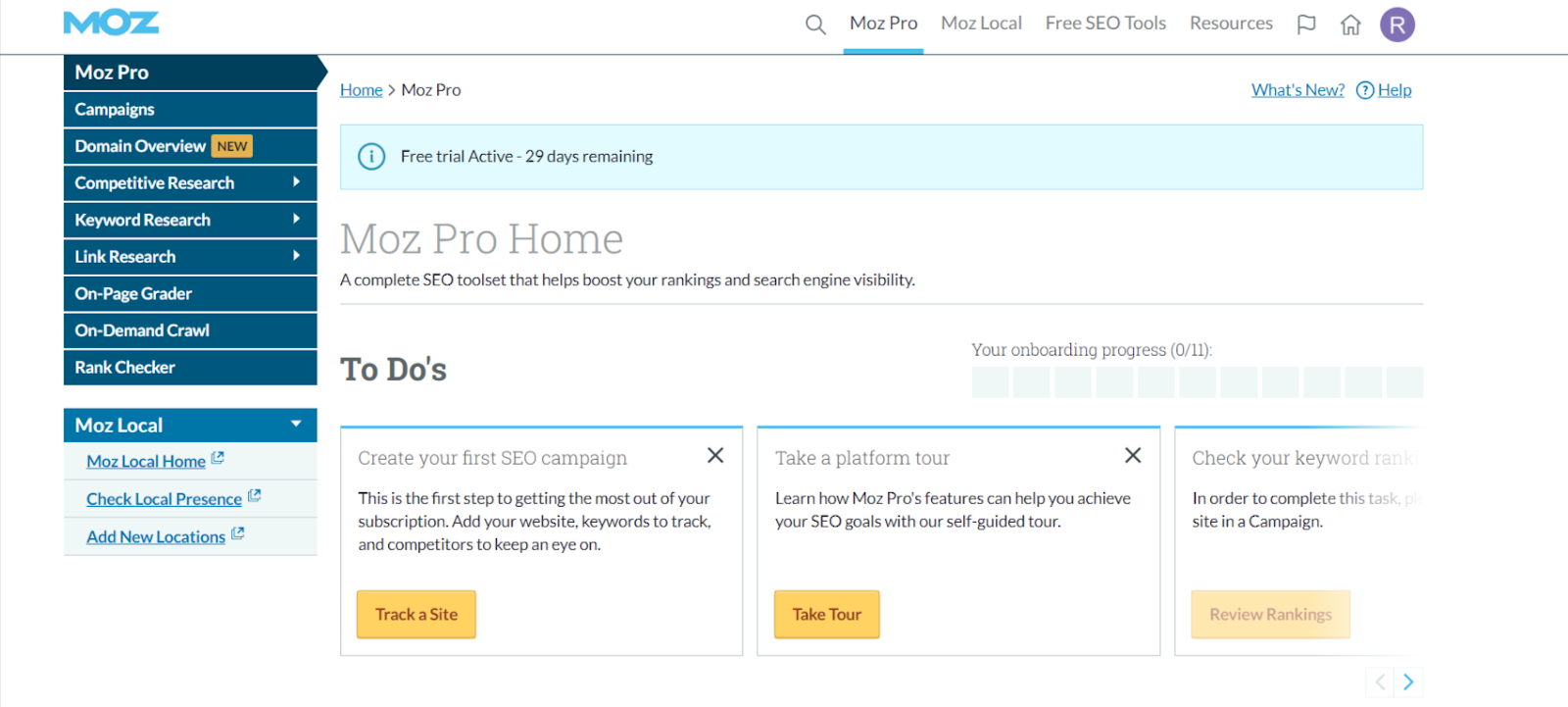
To the left, you will have both individual tools and toolkits. For example, the Domain Overview and On-Page grader are individual tools.
While Keyword Research, Competitor Research, and Link Research are tool kits with 3-4 tools under them.
To the top right corner, you can access their help center and new tools that they have just launched. In the middle they have got you a list of To Do’s that serves as a guide to simplify your first experience on Moz.
Moz Pro Features Review
Domain Overview: 4/5
Domain Overview is a recent addition to Moz’s collection of features.
We think that this feature has covered every factor’s overview of your Domain from summary to Link distribution, competitors, keywords, and whatnot.
To start the analysis process you have to enter the Domain URL and choose the country you are targeting.

One thing that we find quite unique is that Mo has categorized its training resources as per feature and placed them in every feature dashboard.
For example, in the domain overview dashboard, you will find a detailed guide to every aspect just below the dashboard.

Anyways, after entering those details you will have the complete overview report in a few seconds.
Honestly, we are quite impressed with how soon Moz came up with all the information.
Other SEO tools take at least 30 sec to 1 minute but Moz will give you the result in 10-15 seconds.

At first glance, you will have the Summary of your Domain.
The following are the metrics displayed in your Summary:
- Domain Authority
- Brand Authority
- Page Authority
- Linking Domains
- And ranking Keywords

Below the summary, you will have a graphical representation of DA, PA, and Linking domains over time. [ Screenshot Above]
In the case of the website we have taken, the DA has been consistently at 94 for a year now.
You can also filter out the time frame you want to view this data. Customizing the time frame will help you understand the growth of the site precisely.
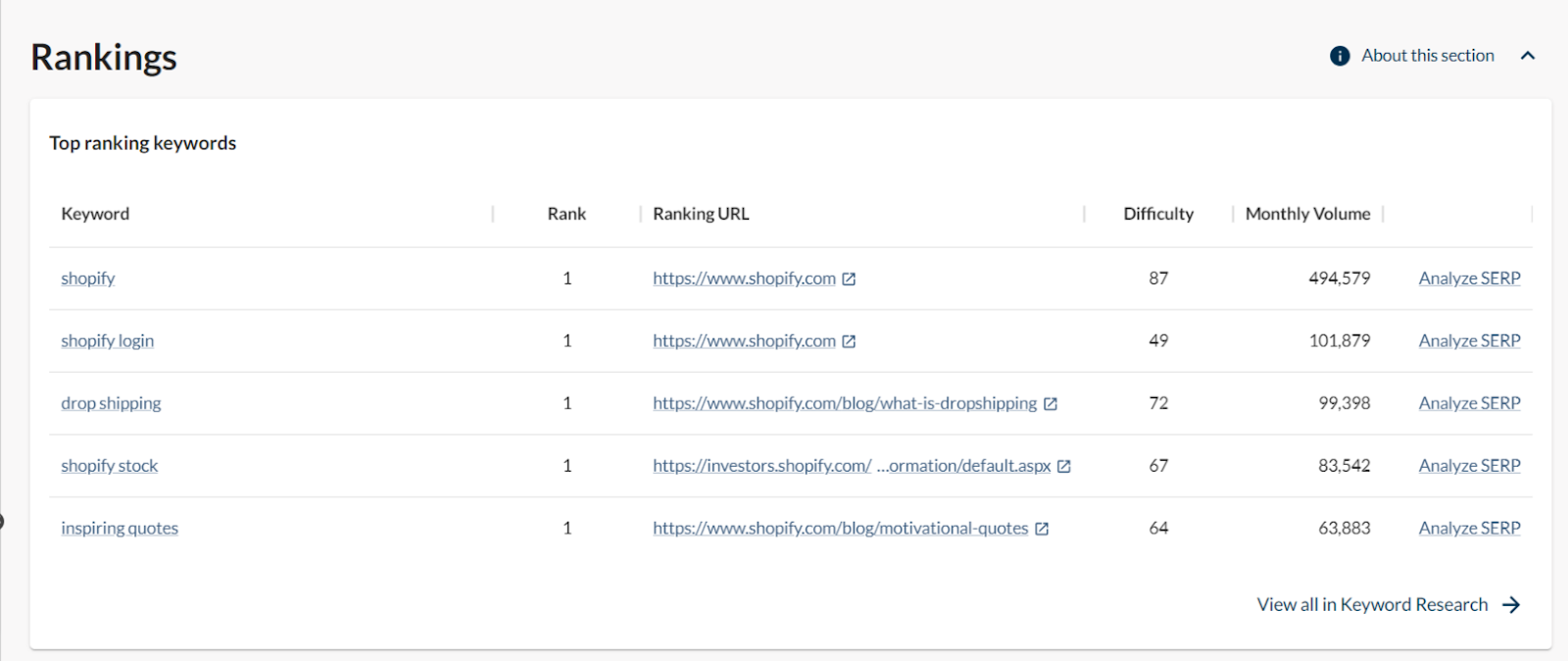
Scrolling down a bit, there will be a list of top-ranking keywords. These are the keywords that bring in most of the traffic to your website.
Each keyword is displayed along with its Monthly Search Volume and difficulty.
It’s a good bird’s eye view of keywords.
But to analyze them in detail, you can go to the Keyword Research feature or click on View All Keyword Research in the right corner of the Interface.
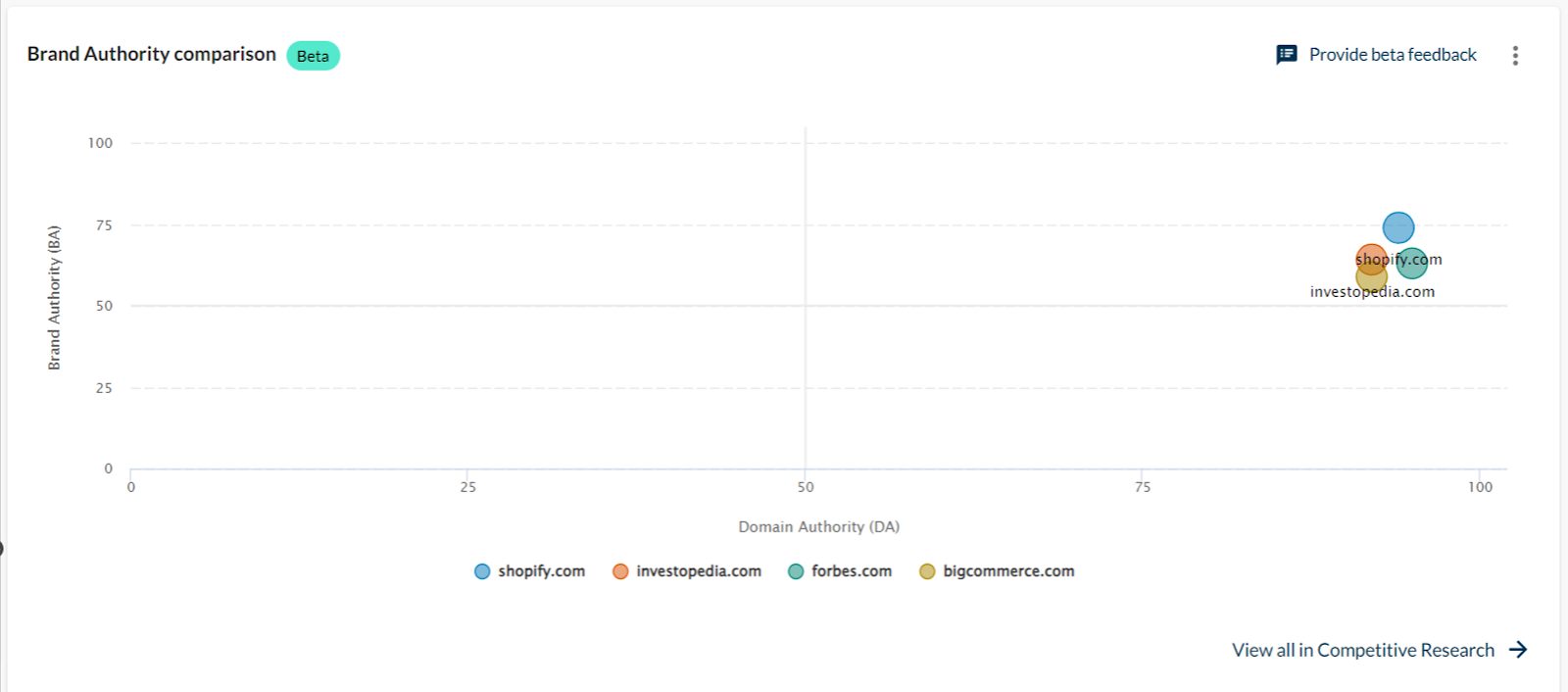
To help you understand the ranking keywords better, Moz has a Rank Distribution Graph that presents a number of keywords in a particular ranking Range. [Screenshot Above]
For example, Shopify has approximately 50k keywords that have SERP positions between 1-3, 78k with positions 4-10, and so on.

Keywords alone will not help with understanding where your domain stands. For that, you need to know your competitors.
So, below Keyword distribution, you will find an overview of your top competitors with their Ranking keywords, keyword distribution, DA, PA, and BA.
Then again, it’s just the top view of your competitors, you can always have a detailed competitor analysis, in Moz’s competitor research feature.

Moz also has a visual Brand Authority comparison of the top 4 competitors. [Screenshot Above]
It gives you an idea of your brand’s strength compared to your competitors. You can know if it is too high, too low, or almost the same as your competitors with just a glance.
If it’s too low, look for issues in your brand’s messaging and try to fix another aspect of SEO.
That said, Moz doesn’t really analyze what is the issue in particular with your domain.
Having a list of issues and tips to fix them can be a goldmine which unfortunately Moz Lacks.
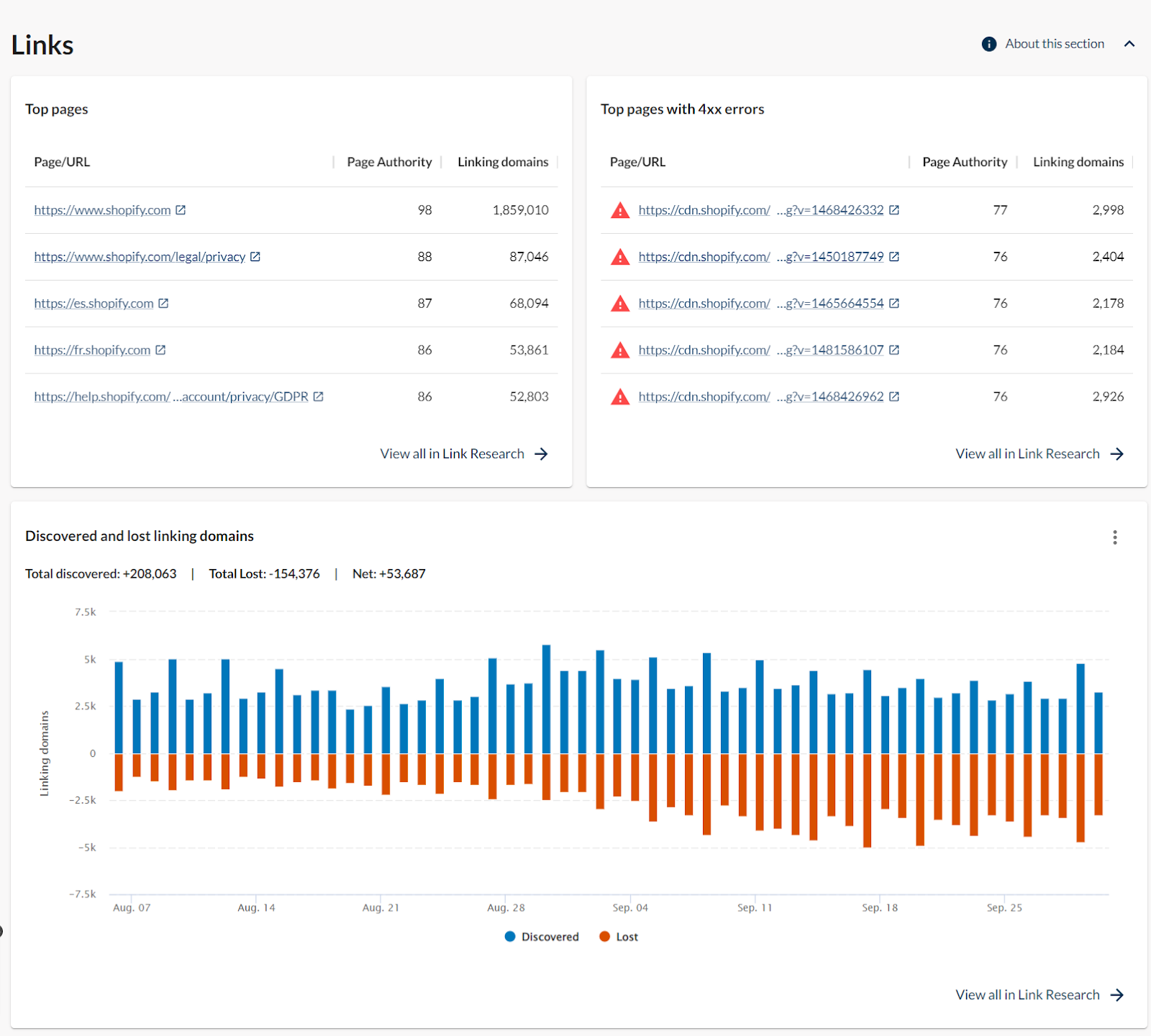
The next aspect of having a domain that outranks all its competitors is its strength of backlinks.
In the links section, you will have a list of top pages of your site that have backlinks as well as URLs with 4xx errors.
That’s not it!
You also have an analysis of New and Lost linking domains to your website. You can analyze them for a particular time frame.
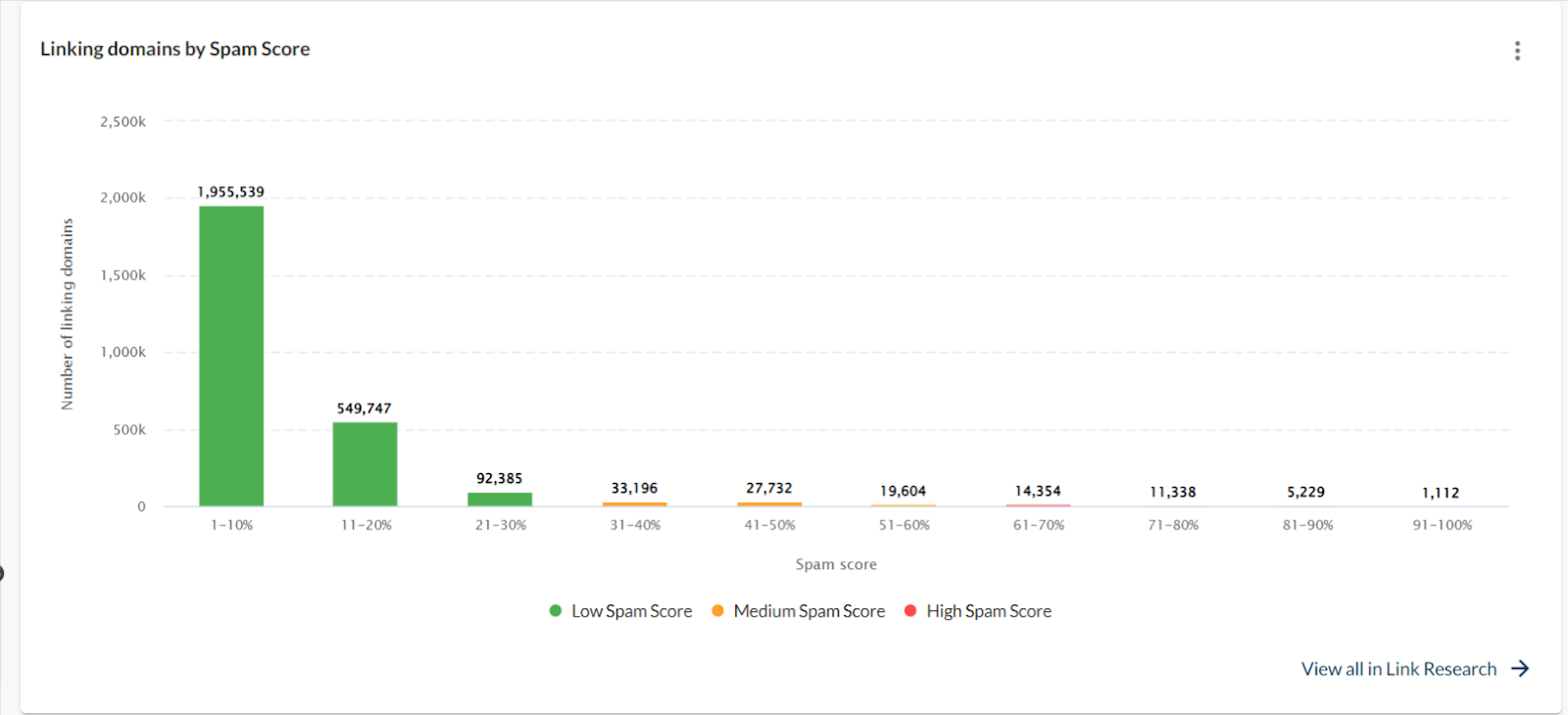
Lastly, you have a bar graph of linking domain distribution with respect to the spam score.
Spam score shows the percentage of features in a website that is similar to the feature of the website that has been penalized by Google earlier.
A spam score of 1-10 is considered good, 20-40 is medium and anything above 60 is risky.
One drawback we find in Moz is that, unlike most SEO tools, Moz Pro doesn’t have any short description of its metrics when you toggle on them. This is really important to enhance user experience.
Beginners might not be friendly with some of these metrics. They have to go to Google to search for the term which is hectic.
Competitor Research
They have two tools under competitor research one is True Competitor and the other one is Keyword Gap.
Let’s review them one by one.
True Competitor

This is the main dashboard of True Competitor. [Screenshot Above]
True Competitor allows you to check the top 25 competitors for your website.
But the question is, how accurate is that list?
To test the accuracy, we took two websites, the first one is Shopify and the second one is Mensjournal.
Here’s what the True Competitor came up with.
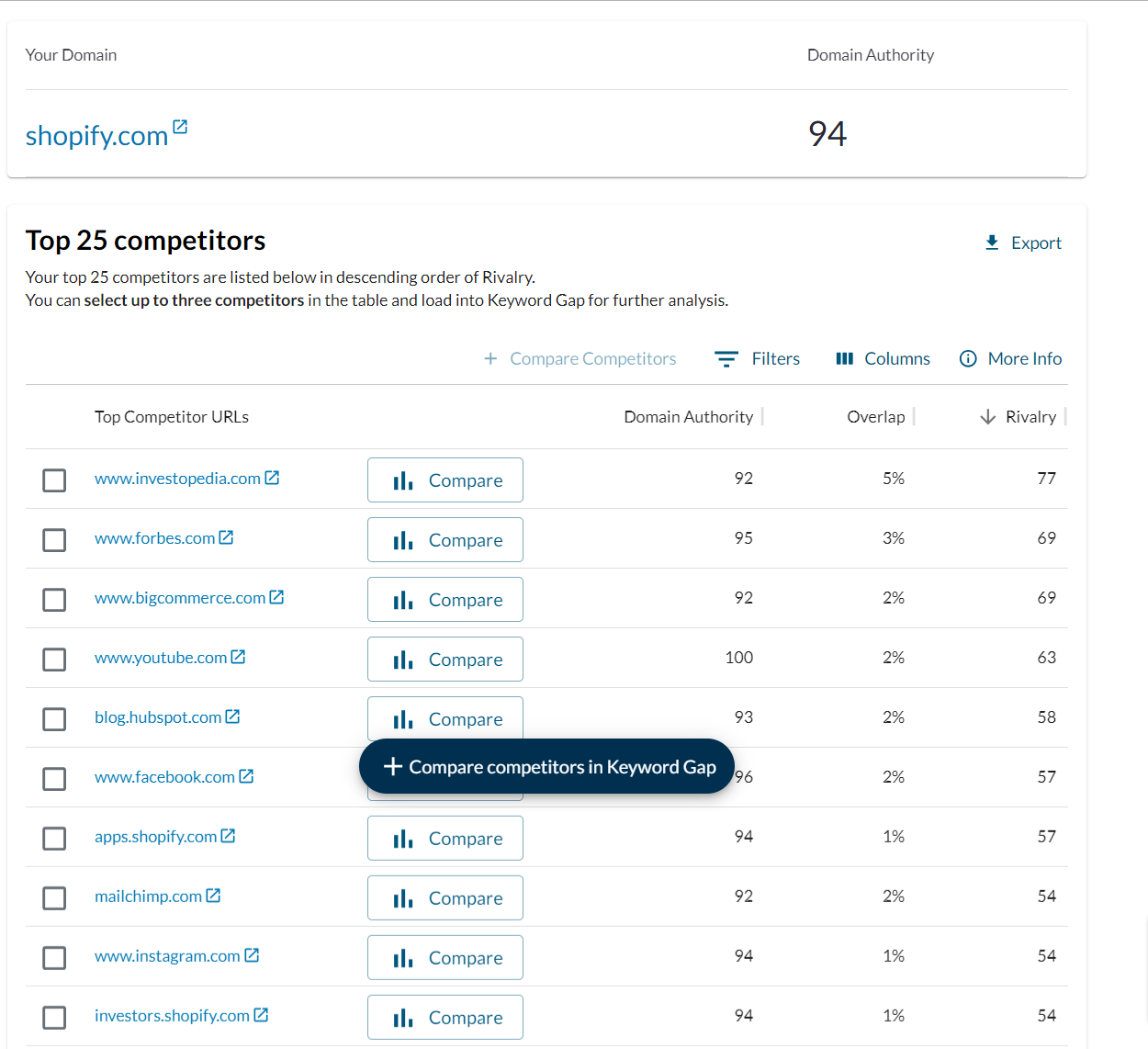
As per True Competitor by Moz, Shopify’s top competitors are Investopedia and Forbes.
Investopedia is the world’s top blog for financial content Investopedia and Forbes is a business magazine.
These two are from completely different niches to each other and for Shopify as well which is an e-commerce platform.
While they might rank for similar keywords, they are definitely not the true competitors of Shopify.
Yes, you can analyze their website for particular keywords, but looking into their marketing strategies won’t do any good.
However, let’s not jump to conclusions.

To test this further we took another blog website which was Mensjournal. Although the results were not 100% accurate, it was pretty close.
They were competitors from the same niche targeting almost the same audience. You could really gain some insights by looking into these websites.
After testing it with a few more websites we have arrived at the conclusion that if you are a blogger True Competitor can come up with some good competitors.
But it cannot analyze competitors based on your niche, target audience, etc, only the keywords that you are ranking for.
Keyword Gap
To find the keyword gaps you have to enter your website and your top three competitor’s website.
Next, select the location you are targeting and click on Analyze Competitor.

That’s it, you will have three sections, site overview, keywords to improve, and top competing content.

The site overview will give you the total number of ranking keywords, their top positions, competitor’s page authority, and domain authority.
If you look above, mensjournal.com the Domain Authority and Page authority are similar to its competitors.
However, it ranks for very few keywords compared to its other two competitors. It simply suggests that menjournal.com has tons of keyword opportunities to work.

Coming to the next section, you will find a list of keywords that have a scope for improvement. Honestly, this is the best thing we have come across in competitor analysis so far.
Look at that, you don’t have to analyze each of your pages separately and see the keyword they are ranking for, the position, etc, and then decide which one to improve.
You can simply come to this section and directly start working on them.

The last section in Moz’s competitor analysis is top competing content. Here you will find the top-ranking content of your competitors and the keywords they are ranking for.
You can click on the URL to have an overview of your competitor’s top-performing posts.
That’s it, we give their competitor analysis a 4/5.
Keyword Research: 4/5
Moz offers keyword research in two categories. One is Explore by Site and the second one is Explore by keywords. We will get to each of them.

In Explore by Site, you can enter only your site to get a detailed analysis of the keywords you are ranking for, keyword distribution, etc.
Or, Moz offers a better way where you can analyze two of your competitors’ keywords along with yours.
Here, we will be reviewing the second way.
All you have to do is enter your root domain and click on analyze.
Then enter two other competitors and click on compare sites.
Once you do, this is what you will get at first glance: [Screenshot Below]
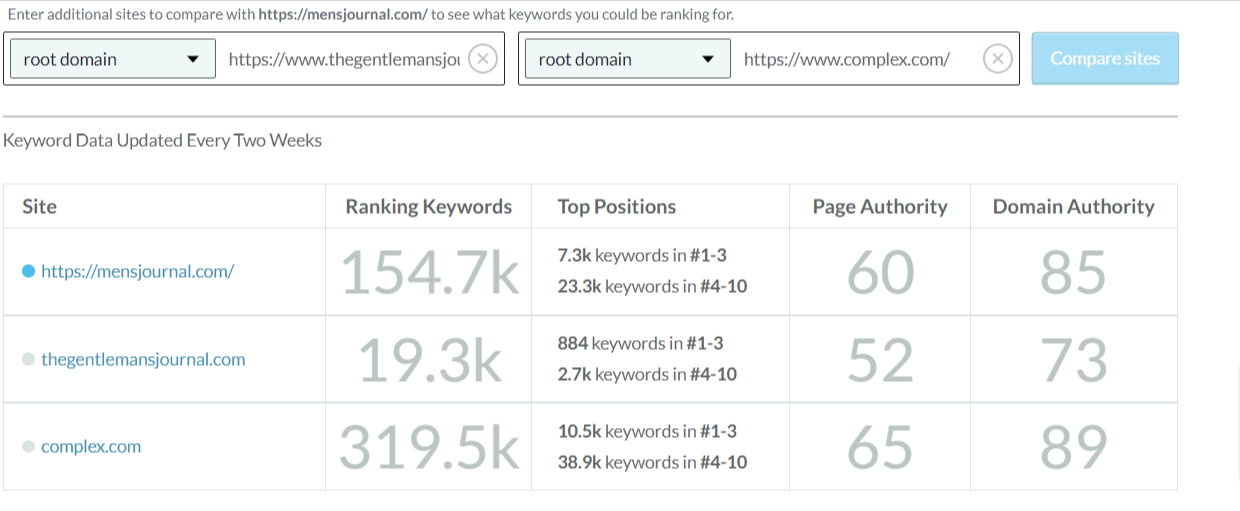
A comparison of total ranking keywords in each site, their top positions, page authority, and domain authority.

The next one we have is the top-ranking keywords. This gives a comparison of your top-ranking keywords and how your competitors are performing in those keywords.

Finally, we have the rank distribution of each site in the form of a bar graph. This section presents the keywords in each site that rank on different position ranges like #1-3, #4-10, etc.
Coming to the second way, we have explored keywords where you have to enter the seed keyword instead of your site.

Once you do, Moz will come up with interesting insights on the keywords. There are data on Monthly Volume, Difficulty, Organic CTR, and priority.
Although these metrics have different names you can click on learn more about [metrics] and find out a detailed guide outlined just for you.
Link Research: 4.5/10
On-page SEO cannot lift you up all alone. For your website to rank, you must have a solid Off-Page SEO strategy.
Link Building is one of the most crucial parts of your Off-page strategy whether you realize it or not.
That said, to build a proper strategy, you need to dig deep into your competitor’s backlink process as well as monitor and analyze your current website.
So, let’s find out how well Moz Pro’s Link Research can help us!
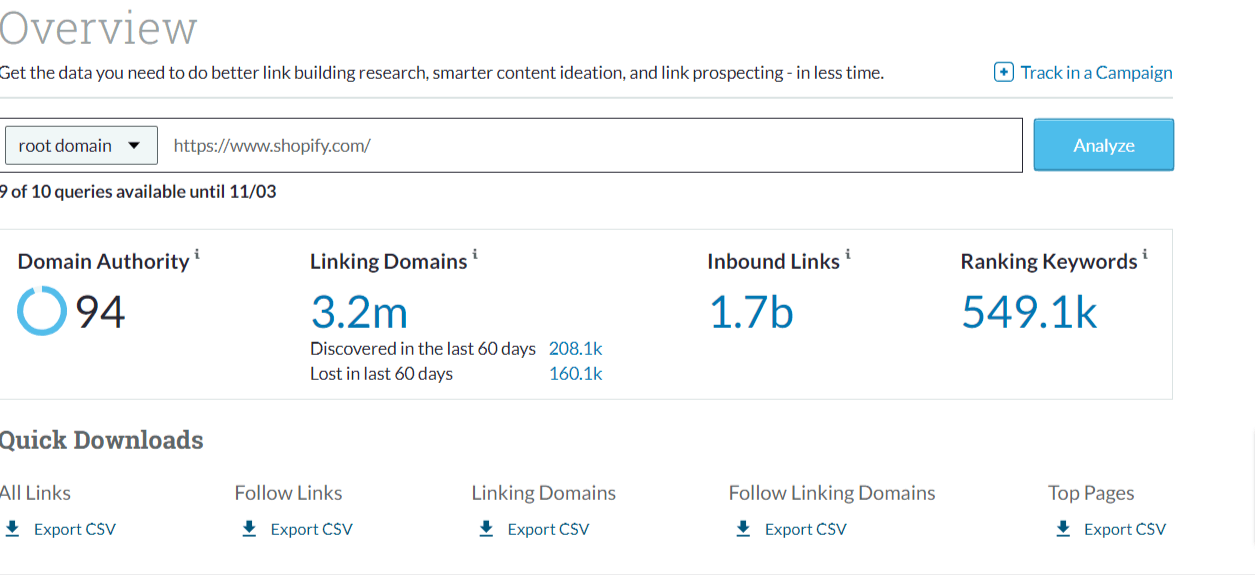
Like any other tool, the first thing you will come across is an overview of your website’s backlink status.
You can have a glance at the total number of linking domains, inbound links, and Ranking keywords of your website.

Scrolling down a bit you will have a visual representation of New Links termed as “Discovered” and Lost links to your website.
Thinking of which, this visual representation makes it way easier to compare the overall progress of your website over time.

Another important part of this report is the Follow vs. nofollow analysis.
Here you have everything from your internal and external links to top anchor texts for the site and representation of linking domain to the site.
This is the end of the overview. You can click on some sections to know more.
But, this doesn’t end here, Moz has a detailed overview of each section separately.
Inbound Link: 4/5

Imagine, you have a list of all inbound leads on a website. Wouldn’t it be awesome if you had this much information on your competitors?
To make sure you have that information, Moz Pro allows you to dig into the list of all the inbound links on a website.
Not just that, you will also find the list of Linking Domains on the website along with the DA, Spam Score, Top Links, etc of each linking domain. [Screenshot below]

Anchor Text:
Anchor text is the visible clickable text on any website that redirects you to other pages.
Anchor text clarifies the value of your link and is an indicator to google about what exactly you are linking.
That said, you should always keep an eye on your website’s anchor text and fix them often.

To make the work simpler, Moz analyses your site and comes up with the anchor text that is most commonly used to link to your site. [Screenshot above]

Okay, Top pages analyze a site’s most valuable pages. This analysis is based on the backlinks alone.
But for us, a valuable URL is much more than the number of backlinks they have.
Won’t you agree?
Sometimes not every site that has a huge number of backlinks ranks on the top, and at times a website with few backlinks can come on the top because of the quality of content it produces.
We aren’t saying that backlinks aren’t an influential factor. It is, but not the only factor one should consider.
That said, we don’t think this section is of much use.
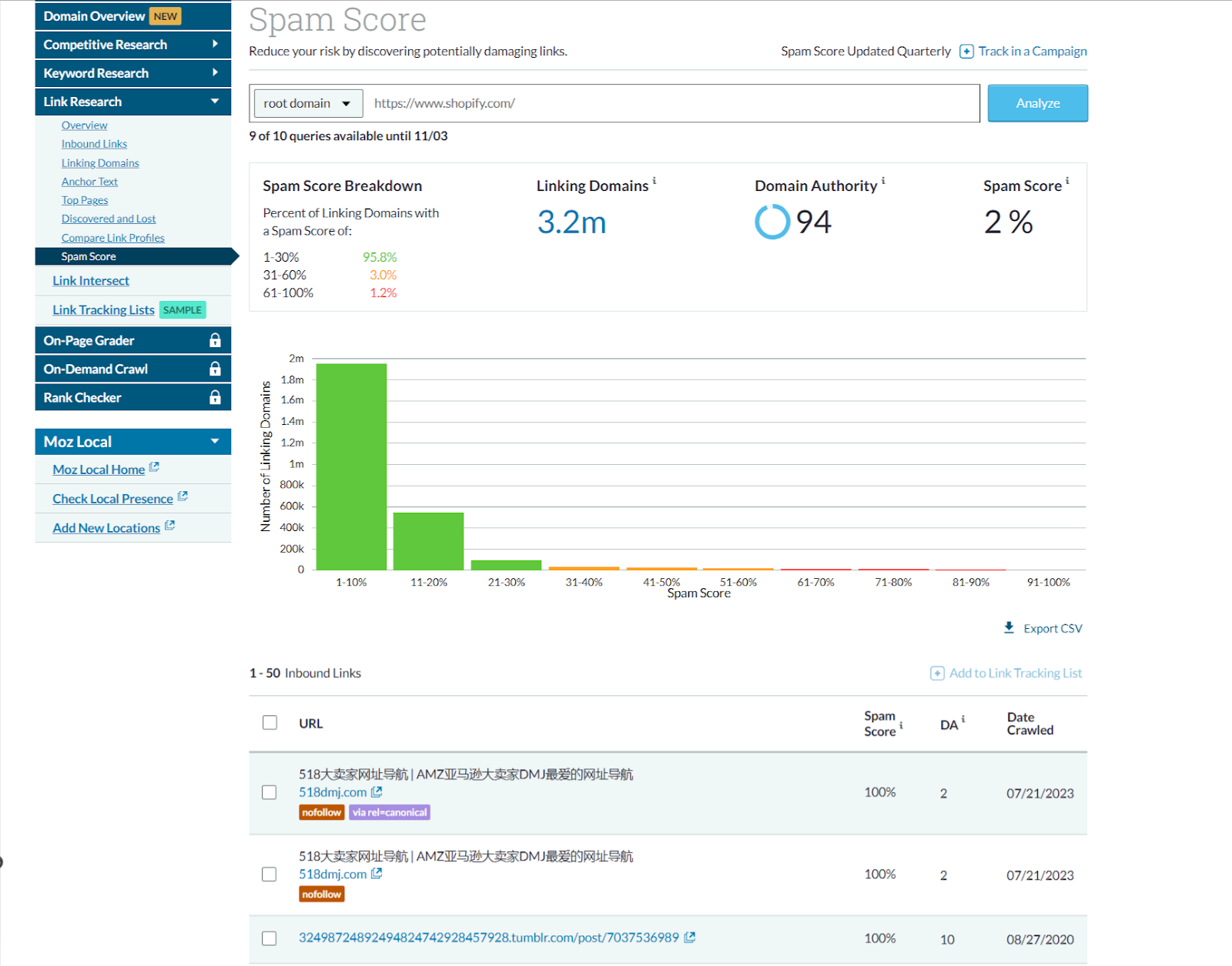
The last and final one is the Spam score of the site. The tool offers a thorough breakdown of the spam score of linking domains.
It visually represents the breakdown by categorizing the backlinks into a spam score of 1-10, 11-20, 21-30, and so on.
Below that, the Link Research tools also jot down the links with the highest spam score. This will help you to directly contact the website owner and ask them to remove the link to your website.
Rank Checker: 3/5
Moz has a pretty basic Rank Checker.
This is their primary dashboard for Rank Analysis.

You have to enter the Keyword you are targeting, URL of the website you want to track, the Search engine, and finally the target Country.
Once you have filled in the information, within 5-10 seconds you will have the ranking of the URL.
Moz has a few metrics covered in its rank tracking feature where you can have an overview of a particular page of your website.
It showcases the ranking position on Google, Volume of Keywords, Difficulty, etc.

Of course, the rank tracking doesn’t even come close to the one offered by Semrush and Ahrefs, but if your website is only a few months old, this much information will do.
One more thing we are disappointed with is that Moz doesn’t have a site health score or doesn’t list out the issues in a particular URL that will help rank better.
These two factors would have actually made the feature super useful.
Our score: 3/5
User Reviews On MozPro
“When our company searched for a new SEO tool, we came across Moz Pro and gave it a go, while only our marketing team used it, the feedback we got back was great, the generated metrics and reports it produced and all its Tips to optimize your campaigns and landing pages were great.”
“Moz Pro is one of the SEO tools we use when doing keyword research, comparing rankings with competitors, and looking at technical SEO. Multiple individuals use Moz Pro, including the web team, marketing team, and content marketing team. This tool helps us increase our SEO visibility and helps us track our progress as we implement changes.”
“ We use Moz Pro on our marketing team to help plan our SEO and content strategies. Inbound is a big part of our overall approach, and Moz helps us make sure to target the keywords that attract the audience that we’re really after. It also helps us discover other terms to use in our content.”
Data Aggregator Review on MozPro
Knowing a few reviews is not good enough. If you really want to know what people feel about a particular tool, you should head to data aggregator sites.
They see the overall rating for the software and then decide.
To make the whole process easier we have created the ratings from top 3 review sites. Let’s have a look at them one by one.

The first one we have here is G2 where 391 users have given Moz an overall rating of 4.4.
Not bad huh?
The number of people who have reviewed it is quite more compared to tools like SE Ranking or SpyFu.
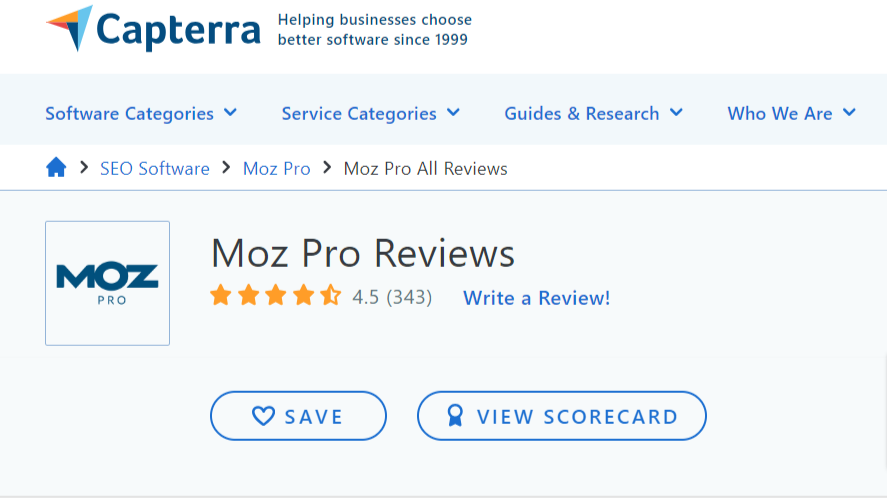
Moving to the next review platform we have Capterra where Moz has received a rating of 4.5 from 345 users.
We are impressed, it is a pretty good rating actually with the number of users being almost same as G2.
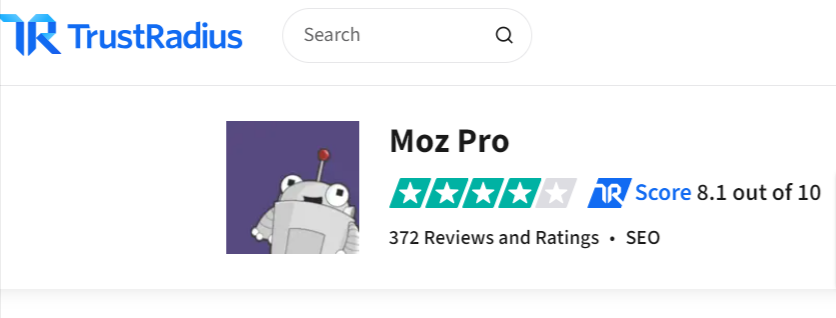
Now, the last one we have got you is TrustRadius. Trust radius gives a rating out of 10. Moz Pro has successfully got 8.1.
We were kind of expecting something around 9-9.5 but 8.1 is good too. Especially when you have 371 users reviewing the tool.
Moz Pro User-Interface
Some find the User-Interface a bit outdated. However, Moz has kept it super clean and easy to navigate.
Once you sign up, you will land at the main dashboard which has a menu on the left-hand side.
From there you can access all the tools Moz Pro has in its collection.
Apart from that, Moz has tons of guides that will help you to get familiar with the tool.
MozPro Customer Support
The Moz Pro platform offers a help hub with 24/7 email support, but no phone number or live chat, which compares unfavorably with SEMrush and Ahrefs.
With their resources and blogs it’s unlikely that you won’t be able to resolve the issues by yourself.

However, if you want to resolve an issue ASAP, it’s better to write to help@moz.com directly by filling out the contact form. Moz Pro offers 24/7 email support.

They also offer live chat, but only for higher-pricing plans. The only thing that’s missing from their customer support is a phone number you can contact directly.
Moz Pro Pricing
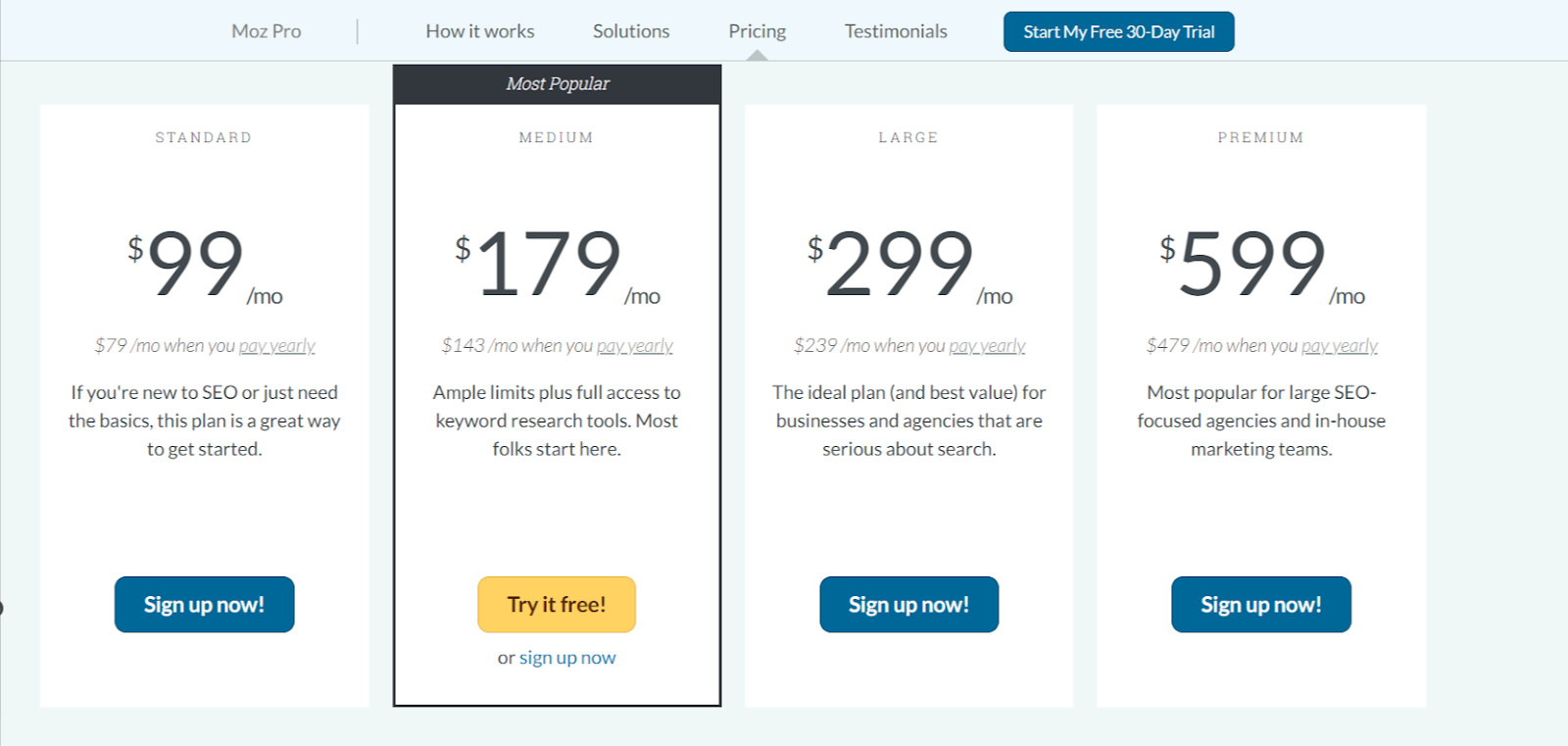
| Plan | Standard | Medium | Large | Premium |
| Track & Crawl Campaigns | 3 | 10 | 25 | 50 |
| Keyword Rankings (total search results collected) | 300 (1,200) | 1,500 (6,000) | 3,000 (12,000) | 4,500 (18,000) |
| Mobile Rankings | Yes | Yes | Yes | Yes |
| Pages Crawled/Week (total pages/mo.) | 100,000 (400,000) | 500,000 (2 million) | 1,250,000 (5 million) | 2,000,000 (8 million) |
| Tracked URLs | 60 | 200 | 500 | 1000 |
| Research Keyword Queries/Month | 150 | 5,000 | 15,000 | 30,000 |
| Rows per Keyword Query | 10,000 | 30,000 | 50,000 | 100,000 |
| Backlink Queries/Month | 5,000 | 20,000 | 70,000 | 1,00,000 |
| Link Tracking Lists | 1 | 30 | 60 | 100 |
| On-Page Grader Reports | Unlimited | Unlimited | Unlimited | Unlimited |
| Access User seats included | 1 | 2 | 3 | 5 |
| 24/7 Support | Yes | Yes | Yes | Yes |
Standard Plan
Price: $99 per month
Who is it for?
The Standard plan is suitable for small to medium-sized businesses and individuals who want basic SEO tracking and analysis tools at an affordable price.
What can you expect?
With the Standard plan, you can track three campaigns, monitor 300 keyword rankings, and crawl up to 400,000 pages per month. It provides essential SEO insights and reporting capabilities, making it a good choice for those just starting with SEO or with modest needs.
Medium Plan
Price: $179 per month
Who is it for?
The Medium plan targets growing businesses and agencies with more extensive SEO requirements. It’s suitable for those managing multiple campaigns and seeking in-depth keyword and page analysis.
What can you expect?
With the Medium plan, you can track up to 10 campaigns, monitor 1,500 keyword rankings, and crawl 2 million pages per month. It provides more advanced analytics and reporting features.
Large Plan
Price: $299 per month
Who is it for?
The Large plan targets medium to large businesses and SEO agencies requiring a robust set of SEO tools and the ability to manage multiple campaigns and extensive keyword analysis.
What can you expect?
With the Large plan, you gain access to a wide range of SEO features, including tracking 25 campaigns, monitoring 3,000 keyword rankings, and crawling 5 million pages per month. This plan is well-suited for businesses with more substantial SEO needs.
Premium Plan
Price: $599 per month
Who is it for?
The Premium plan is designed for large enterprises and SEO agencies with extensive SEO requirements, a need for high-performance crawling, and multiple team members involved in SEO efforts.
What can you expect?
With the Premium plan, you have access to the most comprehensive set of SEO tools, including tracking 50 campaigns, monitoring 4,500 keyword rankings, and crawling 8 million pages per month. This plan is ideal for businesses with significant SEO operations.
What we liked about Moz Pro
- The Keyword Research tool is the best we have come across.
- Identify content areas that need improvement for better rankings.
- Moz offers valuable optimization insights.
- Detailed reports on discovered and lost backlinks. Great link-building opportunities.
- It’s easy to navigate, making it accessible for all.
- Has vast resources to help you throughout.
- One-Month Free Trial
What We Didn’t Like About Moz Pro
- Accuracy of Competitor analysis tool
- No short explanation of metrics on the dashboard.
- Some of the auto-gen visual tables aren’t all that useful for smaller companies.
- Doesn’t cover technical aspects of SEO
- The on-demand crawl is not as robust as Ahrefs.
- Continues to split and introduce additional costs
Final Verdict
Moz Pro offers SEO tools that cater to a wide range of audiences.
It perfectly bridges the gap between advanced tools like Semrush and pretty basic tools like UberSuggest or SE Ranking.
It doesn’t overcrowd features with metrics or leave you with basic stuff like volume and difficulty.
That said, the only thing that is of concern is its accuracy in Competitor Research.
So, if you were thinking of getting Moz Pro to find competitors, we would rather suggest you SpyFu.
Apart from that everything is good. Whether you are a beginner, intermediate-level, or advanced-level marketer, there’s something you can find valuable in Moz Pro.
Most importantly Moz Pro has flexible pricing plans, making it accessible for businesses and individuals with different SEO requirements and budgets.
In a nutshell, if you are someone who is looking to go beyond the normal without giving your brain a hard time, Moz Pro is the one.
Moz Pro Alternatives
Semrush
| Parameter | SEMRush | Moz Pro |
| SEO Features | Comprehensive SEO toolkit | Keyword research, link building, website audits, on-page optimization |
| Additional Tools | Content marketing, advertising, social media, and more | Moz Local, Mozscape API, Moz STAT (separate products) |
| Database for Backlinks | Over 43 trillion URLs | Comparatively less |
| Reports | Customizable reports | Visual representations |
| Training Resources | SEMRush Academy, knowledge base, video walkthroughs | Moz Academy, SEO courses with certification, Webinars, How-to-guides and more |
| Ease of Use | User-friendly interface | Complex navigation |
| Customer Support | Email, chat, phone support | Email support, community forum |
| Price | Starts at $119.95/month | Starts at $99/month |
SE Ranking
| Parameter | SERanking | Moz Pro |
| SEO Audit | Thorough site audit with organized and detailed reports | Site auditor that identifies technical issues |
| Competitive Analysis | Accurate, accessible, and well-presented data | Competitor analysis tools may be complex for beginners |
| Keyword Research | Clear and organized reports, limited question-based keyword generation | Keyword Explorer can be overwhelming, monthly search volume range |
| Backlink Analysis | Tools for analyzing backlinks | Backlink analysis tools available |
| PPC Features | Offers more PPC features | Less focus on PPC features |
| Reports | Customizable and branded reports | Customizable reports and dashboards |
| User Interface | Intuitive and user-friendly | Cluttered interface may be overwhelming |
| Pricing | Lower pricing for basic plan, more projects analyzed | Higher pricing for basic plan, fewer projects analyzed |
| Free Tools | Limited free tools | Useful free tools available |
Ahrefs Vs Moz Pro
| Parameter | Ahrefs | Moz Pro |
| Primary Focus | Started as a backlink analysis tool but has expanded to offer a wider range of features, including site auditing, keyword research, and competitive analysis. | Focuses on providing a comprehensive set of SEO tools, including keyword research, link analysis, and site auditing. |
| Index Size | Boasts a larger index of backlinks and data | Comparatively small index size. |
| Technical SEO | Has a technical site audit tool to identify on-page issues like broken links, redirect chains, and orphan pages. | Not as effective as Ahrefs, but has basic auditing tool. |
| Keyword Research | Has a lot to offer apart from basic keyword research features, like matching keywords, and related keywords with filter options | Keyword research tools with data on search volume, related keywords, SERP details, domain authority, and page authority. |
| Ease of Use: | Can be overwhelming for beginners. | Very simple and easy-to-navigate interface. |
| Pricing | Moz Pro offers pricing starting at $100 per month and goes up to $600 per month for premium plans. | Ahrefs’ pricing also starts at $100 per month and scales up, but their lower-tier plan is less limited compared to Moz Pro’s entry-level plan. |
| Free Trial | 30-day free trial, but with credit or debit card information. | No free trial, but has free tools. |
Conclusion
There you have it!
The good, the best, the bad, and the worst about Moz Pro.
Now it’s your time to decide whether or not Moz is a tool for your requirements or not.
To make a better decision, you can start their 30-day free trial.